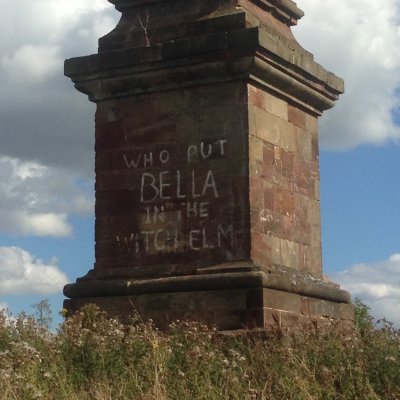- Joined
- Jun 2, 2002
- Messages
- 944
http://books.guardian.co.uk/review/story/0,12084,975708,00.html
I was reading this about Birmingham area. There is an opera about the story and everything. Does anyone know more?:eek!!!!:
Ghost written
When composer Simon Holt heard the strange tale of a corpse discovered in a tree in 1943, he knew he had to turn it into an opera. But who could put his obsession into words?
Saturday June 14, 2003
The Guardian
Laid to rest: the obelisk on Wychbury Hill the site of the strange tale which inspired composer Simon Holt to write Who Put Bella in the Wych Elm?
...
In August 1999 I came across a newspaper article that told of a mystery that would haunt me for the next three years, and in some ways still does, even though the piece it spawned is complete. In 1943 it seems that three boys discovered the decaying body of a 35-year-old woman stuffed inside a Wych elm, in Hagley Wood on the Hagley Hall estate in Birmingham.
The discovery posed a number of questions. Why was she put there, and by whom? Most intriguing of all, who was she? Her corpse soon became known as Bella, a common Black Country name. It is unlikely that we will ever know what she was really called as her teeth couldn't be matched with any dental records, and her skeleton was stolen a short while later from Birmingham University's medical department. For somebody, it seems, no evidence was better than scant evidence.
Why was Bella killed? Perhaps she was privy to potentially dangerous information; a secret that needed to die with her. It was clear that she had had a child, but whose? And where is that child now? One of her hands was missing, revealing the possibility of a black-magic execution. Later it was discovered, buried close by. Was she the hapless member of a coven? Or maybe a spy-ring?
Bella's case remains open, and her macabre story has become part of local mythology in southwest Birmingham. It would seem that everybody has his or her own views on who she was. When I visited the area earlier this year, I stopped two octogenarians out for a stroll, who told me that they thought she had probably been "on the game". As I left them, to walk up Wychbury Hill towards the obelisk on the Hagley Hall estate, I noticed four teenagers adding their own graffiti to the cryptic signs scrawled around its base.
One of them was called Matty (a name I used for the boy who had been the first to discover Bella's body down the tree; the real child died soon afterwards, apparently from the shock). I asked Matty if he knew anything about Bella, and he instantly became cagey, as if it were too delicate a subject to discuss. I was amazed to see, in fresh-looking paint on the western side of the obelisk, the words, "Who put Bella in the Witch elm", almost as if the body had only just been found.
I had a vague idea of the format of the piece, and I knew that I wanted to present it in a pared-down way, as if it could be packed into the back of a van and toured. It became slightly more elaborate as I went on, but I basically stuck to my original plan of an intense 40-minute scena with just a few instruments and two singers describing a moment of catharsis that billows from unknowable and terrifying depths.
I have always been drawn to the idea of myth being at one remove from universal states of mind, thus avoiding sentimentality, but allowing sentiment to burn through. This would be the first time that I had used something that is essentially a living myth. I found it to be as potent, if not more so, than the Greek myths that I had fed off before in pieces such as Minotaur Games and Icarus Lamentations.
I felt that I could go anywhere with such an open-ended story, and that almost anything could be projected on to the fragmentary but lurid details of Bella's possible background and macabre death. Who, indeed, put Bella down that godforsaken tree? Could I in some way get close to answering this riddle already half a century old?
... But Who Put Bella in the Wych Elm? was a ghost I needed to write out and lay to rest myself.
I was reading this about Birmingham area. There is an opera about the story and everything. Does anyone know more?:eek!!!!:





